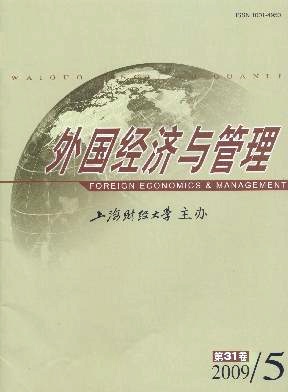结构方程模型中的构成型测量模型研究前沿探析
外国经济与管理 2009 年 第 31 卷第 05 期, 页码:52 - 59
摘要
参考文献
摘要
本文通过对比构成型与反映型测量模型在研究方法与范式上的差异,对构成型测量模型的研究文献进行了梳理,以期提供一个相对完整的构成型测量模型应用框架。本文认为,这两种模型同为潜变量测量工具,基本研究范式相同,但在定义、特点、应用情境、模型识别与评估等多方面存在本质的区别,而统一研究范式和分析软件,是推动基于构成型测量模型的结构方程模型研究的关键条件。
[1]罗胜强,姜嬿.单维构念与多维构念的测量[A].引自陈晓萍等主编.组织与管理研究的实证方法[C].北京:北京大学出版社,2008:255-289.
[2]张伟雄,王畅.因果关系理论的建立———结构方程模型[A].引自陈晓萍等主编.组织与管理研究的实证方法[C].北京:北京大学出版社,2008:290-311.
[3]Anderson,J C,and Gerbing,D W.Structural equation modelingin practice:Areviewand recommended two-step approach[J].Psy-chological Bulletin,1988,103(3):411-423.
[4]Diamantopoulos,A,and Winklhofer,H M.Index construction with formative indicators:An alternative to scale development[J].Journal of Marketing Research,2001,38(2):269-277.
[5]Jarvis,C B,et al.A critical review of construct indicators and measurement model misspecification in marketing and consumer re-search[J].Journal of Consumer Research,2003,30(2):199-218.
[6]MacKenzie,S B,Podsakoff,P M,and Jarvis,C B.The problemof measurement model misspecification in behavioral and organiza-tional research and some recommended solutions[J].Journal of Applied Psychology,2005,90(4):710-730.
[7]谢赞,赵平.构成型模型在用户满意度测量模型中的应用[J].南开管理评论,2005,8(2):4-8.
[8]刘刚,拱晓波.顾客感知价值构成型测量模型的构建[J].统计与决策,2007,22(1):131-133.
[9]Churchill,Jr,G A.Aparadigmfor developing better measures of marketing constructs[J].Journal of Marketing Research,1979,16(1):64-73.
[10]Peter,J P.Reliability:Areviewof psychometric basics and recent marketing practices[J].Journal of Marketing Research,1979,16(1):6-17.
[11]Peter,J P.Construct validity:Areviewof basicissues and marketing practices[J].Journal of Marketing Research,1981,18(2):133-145.
[12]Fornell,C,and Bookstein,F L.Two structural equation models:LISRELand PLS appliedto consumer exit-voice theory[J].Journalof Marketing Research,1982,19(4):440-452.
[13]Bollen,K,and Lennox,R.Conventional wisdom on measurement—A structural equation perspective[J].Psychological Bulletin,1991,110(2):305-314.
[14]Diamantopoulos,A.The error terminformative measurement models:Interpretation and modelingi mplications[J].Journal of Mod-ellingin Management,2006,1(1):7-17.
[15]Wong,C-S,Law,K S,et al.On the i mportance of conducting construct-level analysis for multidi mensional constructs in theory de-velopment and testing[J].Journal of Management,2008,34(4):744-764.
[16]Arthur,Jr,W,and Villado,AJ.The i mportance of distinguishing between constructs and methods when comparing predictors inpersonnel selection research and practice[J].Journal of Applied Psychology,2008,93(2):435-442.
[17]Fornell,C,Rhee,B-D,and Yi,Y.Direct regression,reverse regression,and covariance structure analysis[J].Marketing Letters,1991,2(3):309-320.
[18]MacCallum,R C,and Browne,M W.The use of causal indicatorsin covariance structure models:Some practical issues[J].Psycho-logical Bulletin,1993,114(3):533-541.
[19]Chin,W W.Issues and opinion on structural equation modeling[J].MIS Quarterly,1998,22(1):7-16.
[20]Edwards,J R,and Bagozzi,R P.On the nature and direction of relationships between constructs and measures[J].PsychologicalMethods,2000,5(2):155-174.
②在问卷调研中,测量指标大多用测量问项来表述,但SEM并不只局限于问卷调研,在实验研究中也得到了很好的应用。具体可参阅侯杰泰等(2004)的《结构方程模型及其应用》一文。
[2]张伟雄,王畅.因果关系理论的建立———结构方程模型[A].引自陈晓萍等主编.组织与管理研究的实证方法[C].北京:北京大学出版社,2008:290-311.
[3]Anderson,J C,and Gerbing,D W.Structural equation modelingin practice:Areviewand recommended two-step approach[J].Psy-chological Bulletin,1988,103(3):411-423.
[4]Diamantopoulos,A,and Winklhofer,H M.Index construction with formative indicators:An alternative to scale development[J].Journal of Marketing Research,2001,38(2):269-277.
[5]Jarvis,C B,et al.A critical review of construct indicators and measurement model misspecification in marketing and consumer re-search[J].Journal of Consumer Research,2003,30(2):199-218.
[6]MacKenzie,S B,Podsakoff,P M,and Jarvis,C B.The problemof measurement model misspecification in behavioral and organiza-tional research and some recommended solutions[J].Journal of Applied Psychology,2005,90(4):710-730.
[7]谢赞,赵平.构成型模型在用户满意度测量模型中的应用[J].南开管理评论,2005,8(2):4-8.
[8]刘刚,拱晓波.顾客感知价值构成型测量模型的构建[J].统计与决策,2007,22(1):131-133.
[9]Churchill,Jr,G A.Aparadigmfor developing better measures of marketing constructs[J].Journal of Marketing Research,1979,16(1):64-73.
[10]Peter,J P.Reliability:Areviewof psychometric basics and recent marketing practices[J].Journal of Marketing Research,1979,16(1):6-17.
[11]Peter,J P.Construct validity:Areviewof basicissues and marketing practices[J].Journal of Marketing Research,1981,18(2):133-145.
[12]Fornell,C,and Bookstein,F L.Two structural equation models:LISRELand PLS appliedto consumer exit-voice theory[J].Journalof Marketing Research,1982,19(4):440-452.
[13]Bollen,K,and Lennox,R.Conventional wisdom on measurement—A structural equation perspective[J].Psychological Bulletin,1991,110(2):305-314.
[14]Diamantopoulos,A.The error terminformative measurement models:Interpretation and modelingi mplications[J].Journal of Mod-ellingin Management,2006,1(1):7-17.
[15]Wong,C-S,Law,K S,et al.On the i mportance of conducting construct-level analysis for multidi mensional constructs in theory de-velopment and testing[J].Journal of Management,2008,34(4):744-764.
[16]Arthur,Jr,W,and Villado,AJ.The i mportance of distinguishing between constructs and methods when comparing predictors inpersonnel selection research and practice[J].Journal of Applied Psychology,2008,93(2):435-442.
[17]Fornell,C,Rhee,B-D,and Yi,Y.Direct regression,reverse regression,and covariance structure analysis[J].Marketing Letters,1991,2(3):309-320.
[18]MacCallum,R C,and Browne,M W.The use of causal indicatorsin covariance structure models:Some practical issues[J].Psycho-logical Bulletin,1993,114(3):533-541.
[19]Chin,W W.Issues and opinion on structural equation modeling[J].MIS Quarterly,1998,22(1):7-16.
[20]Edwards,J R,and Bagozzi,R P.On the nature and direction of relationships between constructs and measures[J].PsychologicalMethods,2000,5(2):155-174.
②在问卷调研中,测量指标大多用测量问项来表述,但SEM并不只局限于问卷调研,在实验研究中也得到了很好的应用。具体可参阅侯杰泰等(2004)的《结构方程模型及其应用》一文。
引用本文
贾跃千, 宝贡敏. 结构方程模型中的构成型测量模型研究前沿探析[J]. 外国经济与管理, 2009, 31(5): 52–59.
导出参考文献,格式为:
上一篇:员工敬业度研究现状探析与未来展望





 7159
7159  284
284

